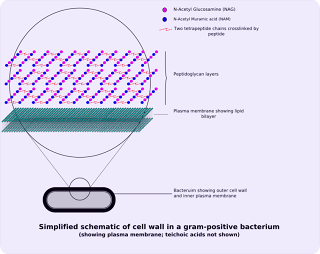Characteristics
- cytoplasmic lipid membrane
- thick peptidoglycan layer
- teichoic acids and lipoids are present, forming lipoteichoic acids, which serve to act as chelating agents, and also for certain types of adherence.
- capsule polysaccharides (only in some species)
- flagellum (only in some species)
- if present, it contains two rings for support as opposed to four in Gram-negative bacteria because Gram-positive bacteria have only one membrane layer.
- The individual peptidoglycan molecules are cross-linked by pentaglycine chains by a DD-transpeptidase enzyme. In gram-negative bacteria, the transpeptidase creates a covalent bond directly between peptidoglycan molecules, with no intervening bridge.
Classification
- Along with cell shape, Gram staining is a rapid diagnostic tool of use to group species of Bacteria. In traditional and even some areas of contemporary microbiological practice, such staining, alongside growth requirement and antibiotic susceptibility testing, and other macroscopic and physiologic tests, forms the full basis for classification and subdivision of the Bacteria (e.g., see Figure, and pre-1990 versions of Bergey’s
- such, historically, the kingdom Monera was divided into four divisions based primarily on Gram staining: Firmicutes (positive in staining), Gracillicutes (negative in staining), Mollicutes (neutral in staining) and Mendocutes (variable in staining).
- Since 1987 and the seminal 16S ribosomal RNA phylogenetic studies of Carl Woese (Department of Microbiology, University of Illinois) and collaborators and colleagues, the monophyly of the Gram-positive bacteria has been challenged, with striking productive implications for the therapeutic and general study of these organisms. Based on molecular studies of 16S sequences, Woese recognised 12 bacterial phyla, two being Gram-positive: high-GC Gram-positives and low-GC Gram-positives (where G and C refer to the guanine and cytosine content in their genomes),which are now referred to by these names, or as Actinobacteria and Firmicutes. The former, the Actinobacteria, are the high GC content Gram-positive bacteria and contains genera such as Corynebacterium, Mycobacterium, Nocardia and Streptomyces. The latter, the Firmicutes are the “low-GC” Gram-positive bacteria, which actually have 45%–60% GC content but lower than that of the Actinobacteria,.The Firmicutes contain the well-known genera that are majority of Gram-positives of medical interest: Staphylococcus, Streptococcus, Enterococcus (cocci), Bacillus, Clostridium and Listeria (bacilli/rods). This group also been expanded to include the Mycoplasma, or Mollicutes, bacteria-like organisms that lack cell walls and cannot be Gram-stained, but appear to have derived evolutionarily from such forms.
- Despite the wide acceptance and practical record of utility of the new molecular phylogeny, a small group, including Cavalier-Smith, still treat the Monera as a monophyletic clade and refer to the group as division “Posibacteria”.
- It is worth stressing here that the description of bacteria as Gram-positive or Gram-negative is ambiguous as it can refers to three distinct aspects (staining result, cell-envelope organization, taxonomic group), which are not necessarily meet at once for some bacterial species.When referring to the type of bacterial cell enveloppe, the terms of monoderm and diderm bacteria are much more appropriate, where the diderm bacteria can even be further differentiated between diderm–LPS and diderm–mycolate, at least
- Most pathogens in humans are Gram-positive organisms. In the classical sense, six Gram-positive genera are typically pathogenic in humans. Two of these, Streptococcus and Staphylococcus, are cocci (sphere-shaped bacteria). The remaining organisms are bacilli (rod-shaped bacteria) and can be subdivided based on their ability to form spores. The non-spore formers are Corynebacterium and Listeria (a coccobacillus), whereas Bacillus and Clostridium produce spores. The spore-forming bacteria can again be divided based on their respiration: Bacillus is a facultative anaerobe, while Clostridium is an obligate anaerobe.
http://laboratory-testing.org/gram-positive-bacteria/








0 komentar:
Posting Komentar